- NEW: John Kerry calls the report a wake-up call to an economic opportunity
- NEW: Environmentalist says political will must change too
- U.N. panel holds out "modest hope" of heading off most global warming
- Sunday's report is the latest in a benchmark U.N. assessment of climate change
(CNN) -- Keeping global warming down to a level people can live with means cutting carbon emissions to "near zero" by the end of the century, even in an increasingly industrialized world, the top U.N. experts on the issue reported Sunday.
That may be doable, but it will take "substantial investments" in everything from planting more trees to replacing fossil fuels with low-carbon power sources like solar, wind and nuclear energy, the Intergovernmental Panel on Climate Change announced in its latest report.
"What this report clearly shows is that the challenges to resolve the global common problem are huge," said Ottmar Edenhofer, a German economist and one of the lead authors of Sunday's document. "But also this report shows that there are some steps to resolve this issue. I would say in that sense the report also outlines the challenges, but it provides hope -- modest hope."
Jennifer Morgan, the director of the Climate and Energy Program at the World Resources Institute, agreed.
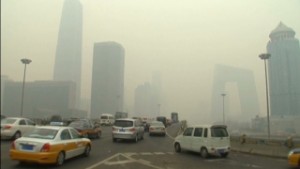 Report: Climate change warning
Report: Climate change warning 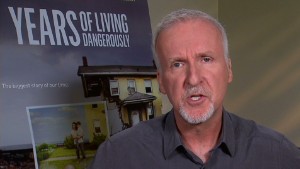 James Cameron tackles climate change
James Cameron tackles climate change  The soaring cost of climate change
The soaring cost of climate change 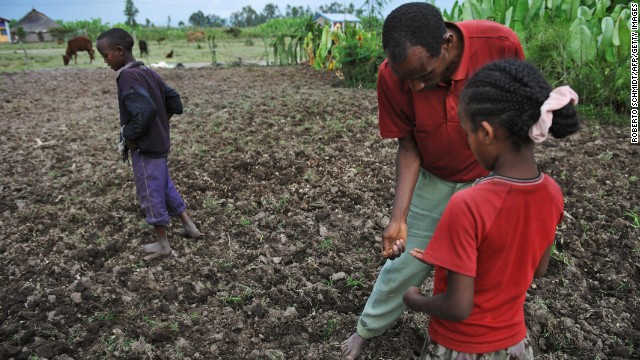 A farmer and his children plant a field with bean seeds and fertilizer in southern Ethiopia in 2008, a year after severe floods destroyed most of the food crop. Ethiopia is the country 10th most vulnerable to climate change effects, according to a 2013 report by Maplecroft.
A farmer and his children plant a field with bean seeds and fertilizer in southern Ethiopia in 2008, a year after severe floods destroyed most of the food crop. Ethiopia is the country 10th most vulnerable to climate change effects, according to a 2013 report by Maplecroft. 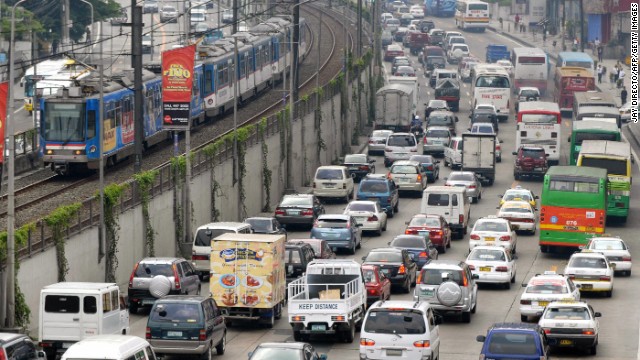 Manila, capital of the Philippines, is one of the five cities, all in Asia and all projected to be centers of high economic growth, that face "extreme risk" from climate change impacts, according to the Maplecroft report.
Manila, capital of the Philippines, is one of the five cities, all in Asia and all projected to be centers of high economic growth, that face "extreme risk" from climate change impacts, according to the Maplecroft report. 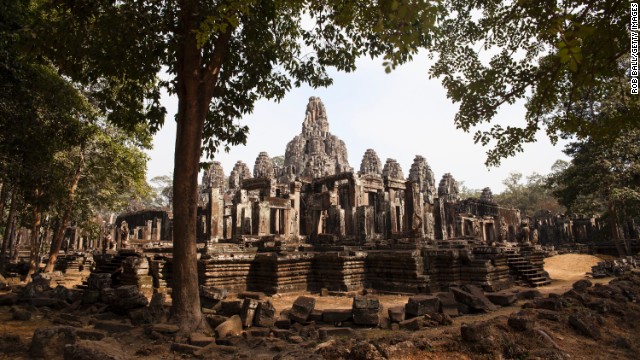 Cambodia is among the Southeast and South Asian countries tipped to face an increased risk of severe flooding because of projected changes in seasonal rainfall.
Cambodia is among the Southeast and South Asian countries tipped to face an increased risk of severe flooding because of projected changes in seasonal rainfall. 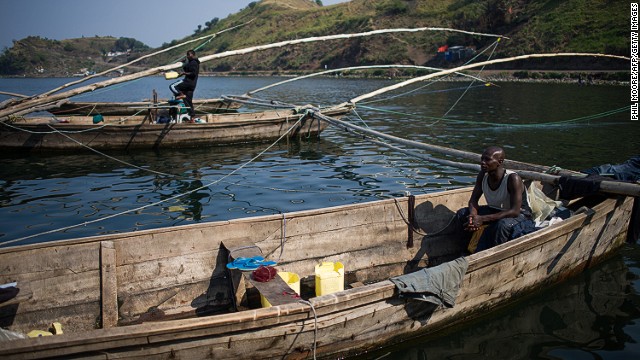 A fisherman sits in a boat on the shore of Lake Kivu in Goma in August. "There are no big fish because of the gas; we only catch small whitebait," one said of the carbon dioxide and methane that saturate the lake.
A fisherman sits in a boat on the shore of Lake Kivu in Goma in August. "There are no big fish because of the gas; we only catch small whitebait," one said of the carbon dioxide and methane that saturate the lake. 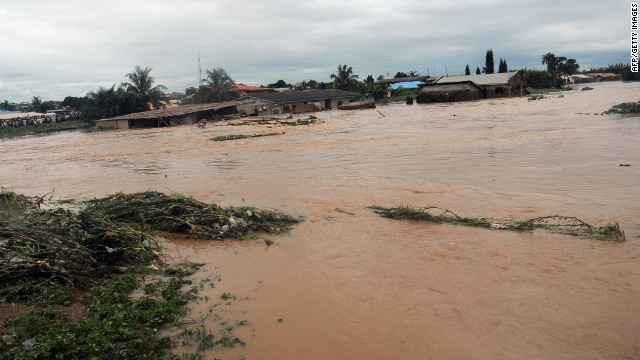 Floodwaters course through Odo Ona in Nigeria's Oyo State in 2011. At least 102 people were killed when a dam burst during torrential rain.
Floodwaters course through Odo Ona in Nigeria's Oyo State in 2011. At least 102 people were killed when a dam burst during torrential rain. 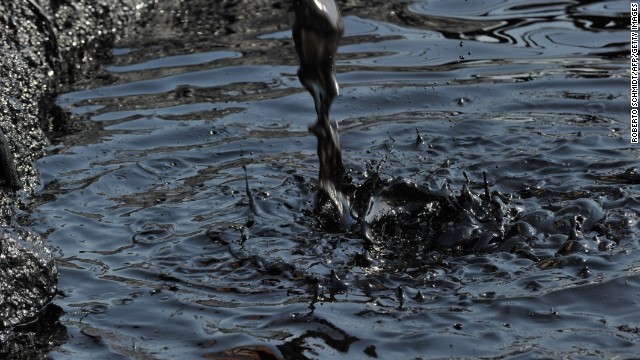 Tainted water pours into a containment pond in a Unity field processing facility in what is now South Sudan, where there are concerns about the environmental damage being caused by the oil industry.
Tainted water pours into a containment pond in a Unity field processing facility in what is now South Sudan, where there are concerns about the environmental damage being caused by the oil industry. 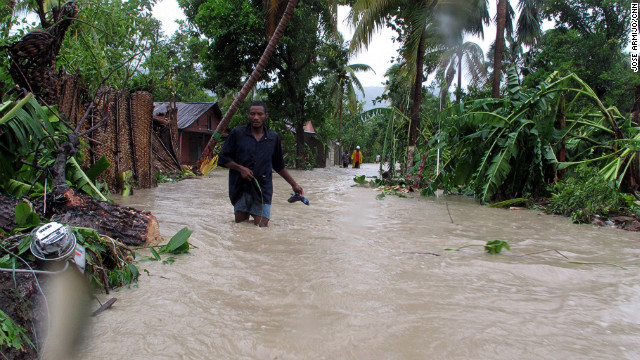 Residents of Jacmel, Haiti, make their way through floodwaters as Tropical Storm Isaac dumps heavy rains in August 2012. An extreme exposure to climate-related events, combined with poor health care access, weak infrastructure, high levels of poverty and an over-reliance on agriculture have led to the country being categorized as at "extreme" risk.
Residents of Jacmel, Haiti, make their way through floodwaters as Tropical Storm Isaac dumps heavy rains in August 2012. An extreme exposure to climate-related events, combined with poor health care access, weak infrastructure, high levels of poverty and an over-reliance on agriculture have led to the country being categorized as at "extreme" risk. 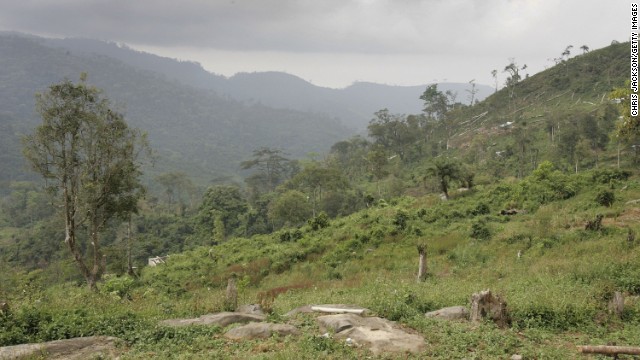 Felled trees lie on the mountainside just outside Freetown. African countries account for 14 of the 20 most at-risk nations.
Felled trees lie on the mountainside just outside Freetown. African countries account for 14 of the 20 most at-risk nations.  Residents walk past the Parliament in Bissau, capital of Guinea-Bissau. African countries rank as at high risk in the index, partly due to their natural susceptibility to events such as floods, droughts, fires, storms or landslides. But their high ranking is also a product of the vulnerability of the population and the inadequacies of existing infrastructure to adapt to or tackle climate change challenges because of weak economies, governance, education and health care.
Residents walk past the Parliament in Bissau, capital of Guinea-Bissau. African countries rank as at high risk in the index, partly due to their natural susceptibility to events such as floods, droughts, fires, storms or landslides. But their high ranking is also a product of the vulnerability of the population and the inadequacies of existing infrastructure to adapt to or tackle climate change challenges because of weak economies, governance, education and health care. 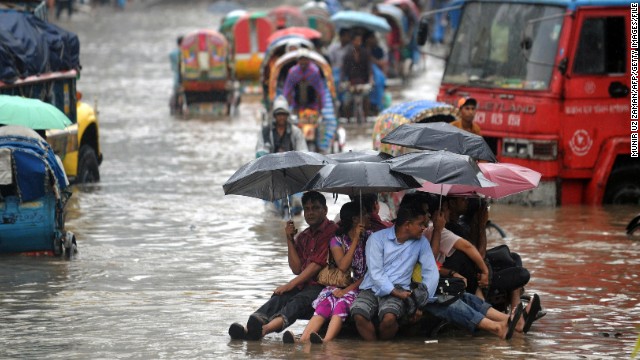 Bangladeshis attempt to stay dry above flood waters in the capital, Dhaka. Bangladesh was ranked by Maplecroft the country most vulnerable to climate change, and Dhaka the world's most vulnerable city, due to its exposure to threats such as flooding, storm surge, cyclones and landslides, its susceptible population and weak institutional capacity to address the problem.
Bangladeshis attempt to stay dry above flood waters in the capital, Dhaka. Bangladesh was ranked by Maplecroft the country most vulnerable to climate change, and Dhaka the world's most vulnerable city, due to its exposure to threats such as flooding, storm surge, cyclones and landslides, its susceptible population and weak institutional capacity to address the problem.  Climate change: 10 countries most at risk
Climate change: 10 countries most at risk "The report shows that the scale of change require to tackle climate change is massive, but the ability to solve it is possible," she said Sunday. "We need to do it quickly, before it will get so expensive to respond that we may hit the points of no return."
Little time left to turn down the world's heat, U.N. says
'Substantial investments'
Edenhofer's modest hope will require more than tripling the share of electricity produced by renewable sources or nuclear power, along with refining the still-evolving technology of capturing carbon emissions and storing them underground. And it will take a coordinated global effort, likely including taxes on emissions, he said.
No direct price tag was attached to that scenario, but Edenhofer said it would require "substantial investments," and more delays just drive up the expected cost. The impact could amount to shaving the projected average growth of the global economy by six-hundredths of a percentage point -- from about 2% per year to 1.94% -- over the coming century. The total global economy was about $72 trillion in 2012, according to World Bank figures.
"We are clearly arguing that achieving these goals is a huge technological and institutional challenge. We are not saying this is a free lunch," Edenhofer told reporters from Berlin, where the final document was approved over the weekend.
"Climate policy is not a free lunch," he said. "But climate policy could be a lunch worthwhile to buy."
In the United States, the second-biggest producer of greenhouse gases, a boom in natural gas along with conservation efforts, more renewable energy and a steep recession combined to reduce carbon emissions by about 10% in the last decade. U.S. Secretary of State John Kerry, who in February called the issue "the greatest challenge of our generation," said Sunday's report is an economic opportunity.
"So many of the technologies that will help us fight climate change are far cheaper, more readily available, and better performing than they were when the last IPCC assessment was released less than a decade ago," Kerry said in a written statement. "These technologies can cut carbon pollution while growing economic opportunity at the same time. The global energy market represents a $6 trillion opportunity, with 6 billion users around the world."
Minds must change, supporter says
But addressing the issue involves more than technological changes, said Morgan, who worked as a review editor for one of the chapters of the report.
"It is about shift of mindsets of political leaders and business leaders to step it up and have the will to implement changes," she said.
Despite more than two decades of efforts to restrain carbon emissions, not only are emissions still going up, they're going up faster than ever, Edenhofer said. Though there's been an increased emphasis on generating power from renewable sources, the use of coal has gone up in the past 10 years, he said.
Limiting the projected increase in global average temperatures to 2 degrees Celsius (3.6 degrees F) over preindustrial times will require cutting emissions of carbon dioxide and other gases by 40% to 70% by 2050 "and to near zero by the end of this century," the IPCC concluded.
Sunday's report is the third part of a benchmark U.N. assessment that comes out every six years. The first, in September, reaffirmed the science behind the warming of the planet; the second, at the end of March, warned that chances to limit the increase in temperatures are slipping away, with the world's poor expected to bear the worst of the effects.
Morgan said it will be important to craft solutions that are fair and take care of those people who are being impacted already or soon will be.
Blueprint for national leaders
The reports are aimed at guiding world leaders as the United Nations attempts to work out a new treaty to limit emissions in 2015. Previous rounds of talks have been strained by disputes among the biggest emitters -- China, the United States and European countries -- and poorer countries whose populations could see the worst impacts first.
About half of the carbon dioxide released into the atmosphere since the dawn of the industrial age has been produced since 1990, the scientists behind Sunday's report concluded. On the current path, global average temperatures could go up anywhere from 3.7 to 4.8 degrees C (6.7 to 8.6 F) over preindustrial levels by 2100.
That would produce a world with higher sea levels, deeper droughts and more intense storms, along with oceans made more acidic by the absorption of carbon dioxide, with impacts on vital marine life that "we cannot estimate at this point in time," IPCC Chairman Rajendra Pachauri said.
There's "a broad set of technologies" that could be deployed to head off that future, Edenhofer said -- many of which are listed in the report. And the document points to potential benefits of the effort, including cleaner air and healthier populations.
One of the most controversial is carbon capture and sequestration technology, which would reduce smokestack emissions and put the carbon dioxide in storage. But the technology is expensive.
"It's not fully proved yet in terms of being commercially viable, but it looks like it has the most promise of all, because it can be coupled with lots of sources of carbon dioxide and essentially be used to neutralize them," said Charles Kolstad, a report co-author and an environmental economist at Stanford University.
If paired with renewable bioenergy sources, it could lead to net negative emissions, he said.
Act now, environmentalists say
Other leaders of some of the world's biggest environmental groups called the report a positive one.
"The IPCC is clear that acting on climate change is possible, beneficial and affordable," said Samantha Smith, the head of the World Wildlife Fund's climate and energy program. "If we act now, costs will be only a very small fraction of global economies. Those who say it's too hard and too expensive are wrong." She said the report should convince investors "to pull your money out of dirty fossil fuels and put it into renewable energy and energy efficiency."
Morgan said individuals can also do that by seeking greener power sources and ways to save energy, and by keeping a close eye on where they invest their 401(k) plans and other savings vehicles.
She also said it would be a a challenge for her organization to make sure that people see there is still hope.
"There is a chance that their children won't have to deal with this problem," she said.
Carbon dioxide benchmark hits new heights, worries scientists
Opinion: Is it time for international agreements to recognize national laws?
CNN's Steve Almasy contributed to this report.
No comments:
Post a Comment